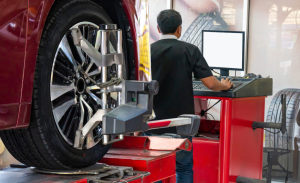For reasons of safety, performance, and economy, it’s important to check wheel alignment regularly on your Nissan vehicle. Misaligned wheels can cause several potentially serious problems, so it’s wise to visit your Nissan dealer whenever you suspect they’re out of kilter.

Vehicle Pulling or Drifting Right or Left
One of the more obvious symptoms of misaligned wheels will make itself known when you drive in a straight line. You’ll either feel the steering wheel pulling to one side, or, more subtly, the vehicle drifts gradually to one side when you lightly grip the steering wheel. This may not seem too alarming under normal circumstances, but in an emergency, it’ll make your Nissan harder to control.
Uneven Tire Wear
Another obvious and expensive sign of misaligned wheels is uneven tire wear. Having to replace tires that have worn prematurely on one edge is hugely frustrating, so it’s wise to keep an eye on your tires if you suspect something is amiss. Better still, visit your dealership at the earliest opportunity to have your suspicions put to rest.
Reduced Fuel Efficiency
Depending on how closely you monitor fuel, you may notice a reduction in efficiency if you have misaligned wheels. This is because the vehicle is working harder to propel itself forward. A reduction of up to 10% in efficiency is possible, so the amount is not trivial.
Rougher Ride, Wobbly Steering Wheel
Wheels that are out of alignment can cause a rougher, noisier ride, which becomes more noticeable at higher speeds. You may detect vibration through the steering wheel or vehicle itself, and tire noise might be louder than usual. A steering wheel that feels loose or unstable is another symptom of misaligned wheels.
What Alignment Involves
Before aligning wheels, the technician examines various aspects of the vehicle to ensure a proper alignment is possible. These include tire pressure and condition and wear and tear on suspension components. An alignment involves checking and adjusting the caster, camber, toe, and thrust suspension angles. When all of these are aligned to specification, your vehicle will run smoothly and efficiently again.
Two-Wheel vs Four-Wheel Methods
Depending on the vehicle design, a two-wheel or four-wheel adjustment is performed. A car with a solid rear axle needs a two-wheel or frontal alignment, whereas vehicles with four-wheel independent suspension require a four-wheel adjustment. The latter type includes many modern cars, small SUVs, and vans. Trucks and some larger SUVs are more likely to have a solid rear axle.
Contact Ed Martin Nissan of Fishers at Fishers, IN to get your wheels checked and running true.




